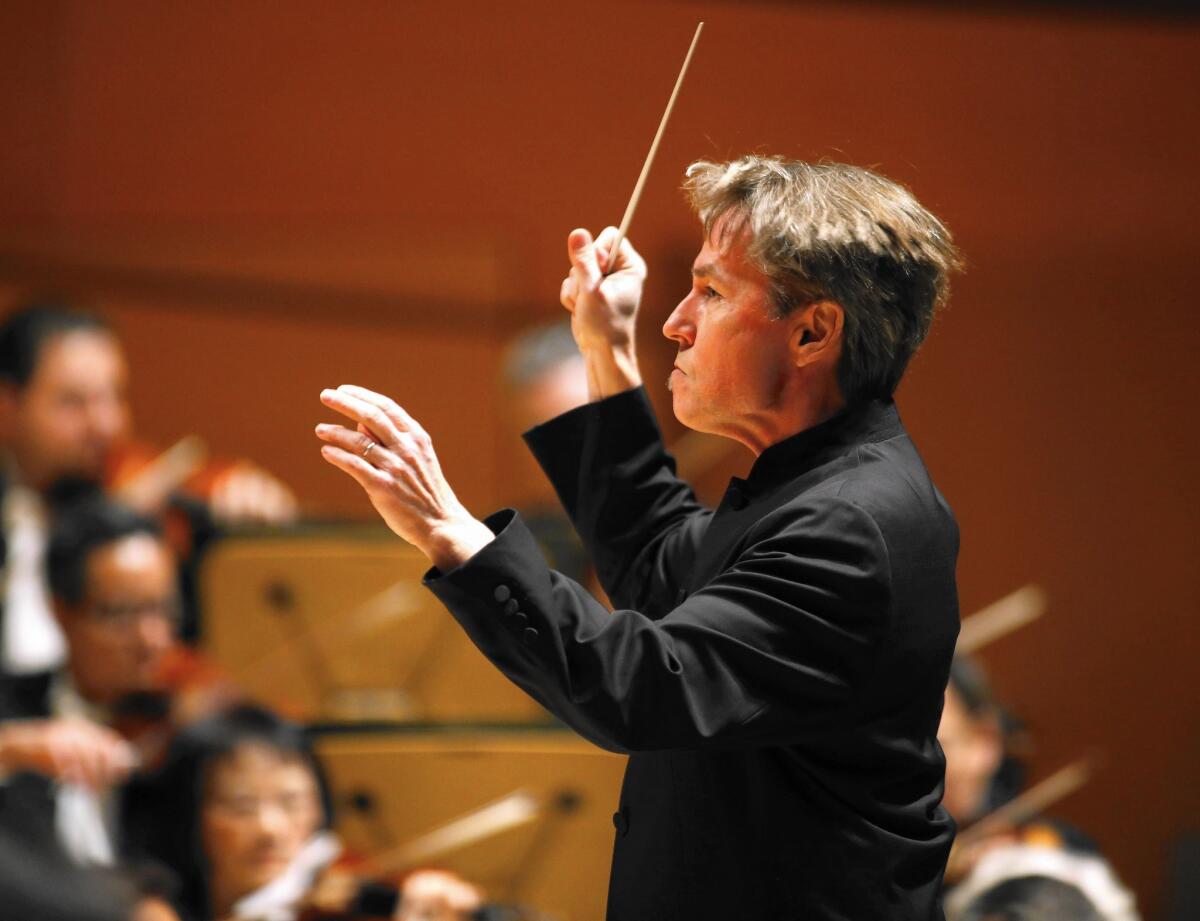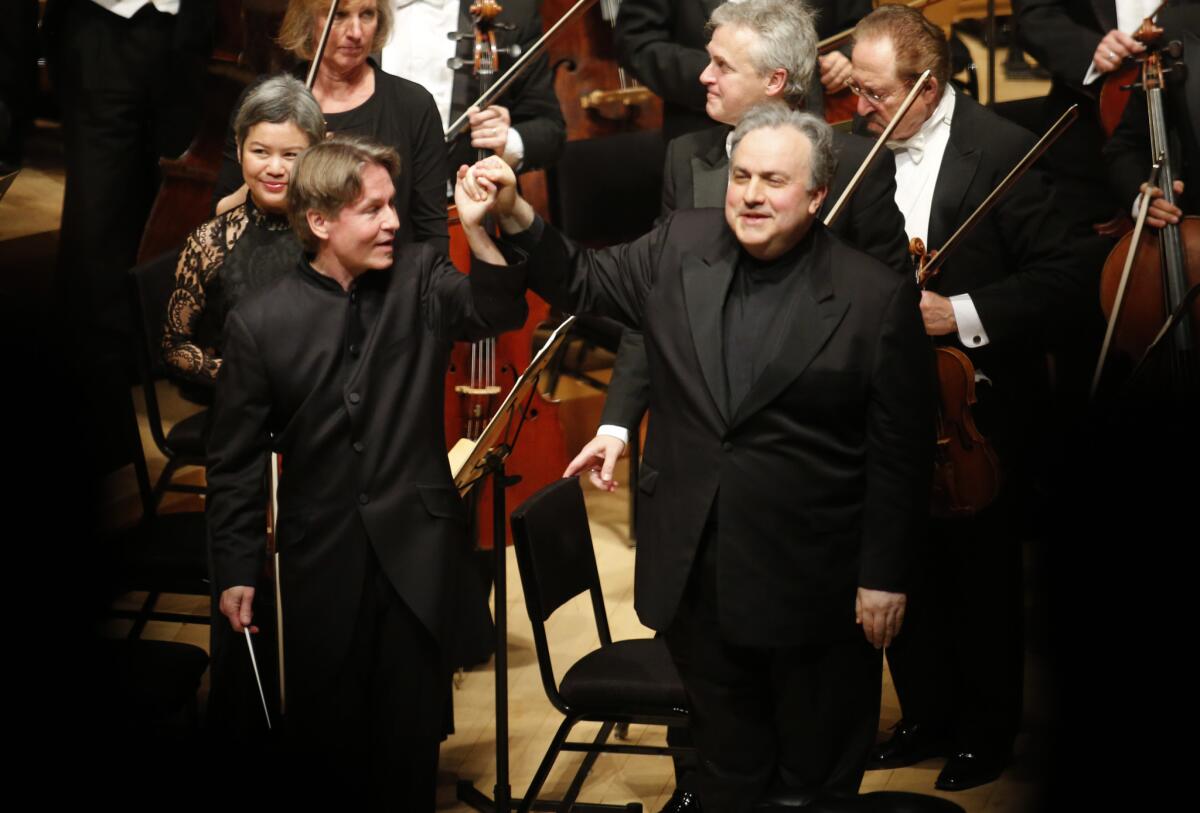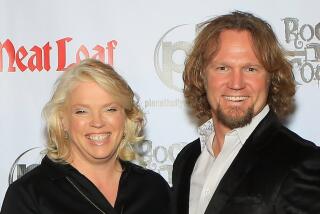Review: A hero’s welcome for Esa-Pekka Salonen at Disney Hall

- Share via
So he stays put.
For a year, the East Coast music press tried to press the New York Philharmonic into hiring Esa-Pekka Salonen as its next music director. For a year, Salonen, who has been the orchestra’s composer-in-residence for three seasons, insisted that he was happy having, after a long struggle, found a balance between composing and conducting and that he was living where he wanted to live — Los Angeles. Finally, New York announced last week that Dutch conductor Jaap van Zweden would succeed music director Alan Gilbert, who steps down in 2017.
And yet Salonen remains the center of attention. On Friday night, he returned to Walt Disney Concert Hall for the first of three weeks leading his old orchestra, the Los Angeles Philharmonic, of which he is conductor laureate, in a brilliant concert. On Monday, he sneaks back to New York to oversee one of the orchestra’s Contact! programs (patterned after the L.A. Phil’s Green Umbrella new music series). The New York Phil’s most ambitious upcoming concert this winter will be Salonen conducting Messiaen’s epic “Turangalila” symphony, with pianist Yuja Wang, in March. Meanwhile, as of Sunday, you had to dig deep (very deep) on the orchestra’s website to find out that Van Zweden would be the new man.
SIGN UP for the free Classic Hollywood newsletter >>
Whether New Yorkers are happy with the outcome, well, you will have to ask them. As for the Angeleno reaction, no asking is needed. An avid audience gave Salonen a hero’s welcome at Disney Hall on Friday. More telling, though, was the response of the L.A. Phil in a singular performance of Mahler’s First Symphony. Conductor and players seemed to organically merge into an individual musical organism, and one with a mind of its own (or perhaps the über-mind of Mahler).
The program, which began with Beethoven’s Piano Concerto No. 1, had several layers of significance. The soloist was Yefim Bronfman, an old, old Salonen — and L.A. Phil — friend (Salonen wrote his Piano Concerto for Bronfman). This was a conventional program, something that would be commonplace in Utah or Uzbekistan (where Bronfman happens to have been born). One question about Salonen’s supposed suitability for New York was whether he would prove as exciting with standard repertory as with his special projects (like his two big February French programs with the L.A. Phil, including a concert performance of Debussy’s opera, “Pelléas et Mélisande”).

Conductor Esa-Pekka Salonen performed with his longtime friend, pianist Yefim Bronfman. Bronfman was the soloist on Beethoven’s “Emperor” Concerto.
And then there was the very fact of Salonen conducting Mahler’s First. Mahler was always a priority with him in his 17 years as L.A. Phil music director. But it was also Mahler’s First that Gustavo Dudamel chose as the signature work for his first season in L.A. He conducted it for his opening-night gala at Disney in 2009, recorded it with the orchestra and highlighted it on his first U.S. tour with his new band.
Since then, Dudamel has made Mahler ever more important, especially with his “Mahler Project,” conducting all nine symphonies here four years ago. But Dudamel’s heavier Mahler has a significantly different character than Salonen’s, and Friday was the first time Salonen had conducted Mahler with the L.A. Phil since he was music director. For this occasion, Dudamel was prominently seated in the hall, and he was one of the first on his feet for the standing ovation.
What was it about that Mahler? Partly, it was lightness, a purposeful playfulness, even when things got quite loud and boisterous. This is a nature symphony. It opens with a sheen of sunrise in the woods, a thin layer of silvery strings playing in the extreme high range that dogs go in for. There are distant brass fanfares. A cuckoo call. Then music for bounding into the meadows. Then the whole world in happy sound.
Salonen began with a silken transparency that hovered over the hour-long performance despite his finding greater degrees of contrast than he had ever before in his L.A. Mahler. For the most part, he let Mahler be, but more so. When the symphony gets bizarre, Salonen pointed that out with glee. He found endlessly fascinating details but without fussing over them.
He also exhibited a greater flexibility of tempos. Mahler began sketching this symphony in 1885, when he was 25, and he fiddled with it up to 1906, five years before his death. This had become the era of Einstein, and Salonen’s interest appeared in Mahler’s early symphony already headed into the 20th century.
He presented the storms and explosions in the Finale as proto-Stravinsky. By the end, the performance had become as much or even more about a study in propulsion, in the arrow and accelerations of time through the filter of relativity.
In seeming contrast, Beethoven’s First Concerto (it was really his second but published first) remained classical. Bronfman is renowned as an explosive virtuoso. He is a burly guy capable of assaulting the keyboard (a few years ago, he had to cancel an L.A. Phil appearance, having broken a finger while getting carried away in a recital). Yet here he was the soul of restraint and elegance.
There is a shared youthful exuberance in the Mahler symphony and the Beethoven concerto, the great composers exulting in their blossoming ingenuity. Bronfman caught that exactly and without excess, Beethoven being Beethoven, not Bronfman. His playing in the slow movement was delicate, exquisite and just as thrilling as when he bangs loud enough to attract the attention of the heavens. Salonen maintained Bronfman-ized balances, making sure that every note in the piano would be heard and highlighted.
Some say that Dudamel has changed the L.A. Phil sound, thickening the textures with rich, vibrato-laden tone. The orchestra Friday revealed that a fallacy. It gives Dudamel what he wants without having lost its now-ingrained Salonen sound. Few orchestras have the opportunity or appetite to channel to two such radically different yet mutually appreciative musical minds. Salonen made the right choice.
More to Read
The biggest entertainment stories
Get our big stories about Hollywood, film, television, music, arts, culture and more right in your inbox as soon as they publish.
You may occasionally receive promotional content from the Los Angeles Times.











